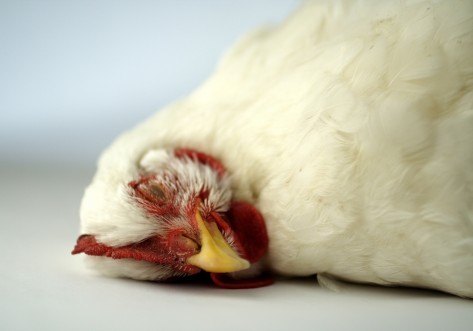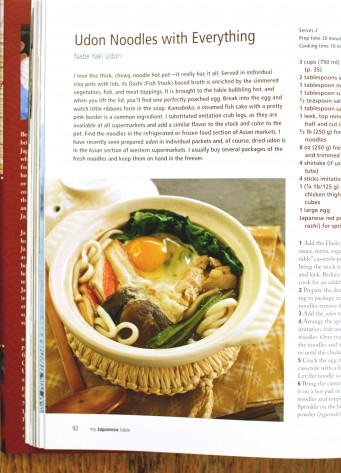Ginger: In Memoriam (October, 2009–January 19, 2012)

To DCCC readers:
Every so often I post something about life at Dowdy Corners—the garden, the bees, and now the chickens. The following story about the death of one of our chickens may seem completely unrelated to the club’s main business of reading cookbooks and preparing recipes, but it’s not: Many of Ginger’s eggs have been used in the preparation of food posted on the DCCC blog (click here, here, and here), and have even made it into print as one of the star ingredients in Udon Noodles with Everything, included in my friend Debra Samuel’s newest cookbook My Japanese Table. On the blog I don’t explicitly talk about where food comes, how it’s grown, and how it gets onto our tables, yet it’s something I think about a lot. Keeping chickens at Dowdy Corners has been one significant part of an on-going experience learning about food. If you don’t keep chickens, you may find this story maudlin; if you do keep them, you will know how easy it is to get attached to these domesticated fowl. This story is one of several I’m working on about our chickens, many of which are not sad at all, but are very happy chicken stories.
-Holly

Ginger’s egg. Page from My Japanese Table (photography by Heath Robbins; styling by Catrine Kelty)
***********
The morning started out innocently. After receiving a handfed breakfast of leftover dinner roll, Ginger, in the newspaper-lined pet carrier she’d been placed in the night before, was ready to be taken to her 8:40 a.m. appointment with Dr. Barcelow to see what could be done, should be done about her “pouch.”
Though not as large and bulbous as it had been before the surgery, when we had mistakenly identified it as an abscess, her abdomen was sagging more, it seemed, every day. Without the aid of muscle, Ginger’s skin was stretching and thinning under the weight of her intestines. When she was tucked in for the night, sitting on the perch, the pouch dangled in mid-air at an impossible distance from her body, like a reluctant teardrop of water suspended from the end of a faucet.
There were other alarming signs: Featherless and exposed to cold January air, the skin on the pouch was scabby in places and showed signs of a small tear, and there were traces of dried blood.
On the way to the appointment, I reminded myself to ask Dr. Barcelow if a sling would work. Something to help support the weight of her intestines, to counter gravity? Of course this might lead to other problems, I considered, perhaps the chicken equivalent of bed sores.
When we arrived at Country Animal Hospital, we were taken to a small office where we waited for Dr. Barcelow. I asked Ginger if chickens have a memory, because, I continued, “If you do, you will remember that you’ve been here before and everything was okay.”
It did not take long for Dr. Barcelow to access Ginger’s condition. She pointed to the scabby, blackened skin, declaring it to be in a very unhealthy and weakened state, and gently squeezed the top of the pouch together, her fingers meeting, giving the pouch a testiclelike appearance, to show us where muscle should be but where there was none. With each of these words, these blows, I physically recoiled and uttered “Oh,” “oh,” “oh.”
We had two choices: Opt for a second round of reconstructive surgery, the success of which Dr. Barcelow was not highly confident about since the first surgery didn’t work, or put her down. Doing nothing was not an option. Eventually the skin would break—Dr. Barcelow estimated this occurring within three to five days—in which case her death would be painful and gruesome.
In a split second we were faced with deciding Ginger’s fate, though I suppose the fox that had injured her the previous June, most certainly giving her the hernia that is now causing us to determine what a chicken’s life is worth, what is the most humane action, and what is the likelihood of future outcomes.
It seemed a shame to put down a chicken who was relatively young, at just over two years, and in perfectly good health, except for this damn hernia problem. Who, through attrition, had risen to the top of the pecking order though she’d started at the bottom. (Without Ginger, Anita, a bossy Rhode Island Red, would rise to the top with no competition.) And who, with a plucky, defiant spirit had defied the odds four times already:
- Fox attacks;
- A maggot-infested wound, no doubt related to the last fox attack, gone unnoticed by us;
- A botched misdiagnosed abscess treatment performed by Mike and me; and
- Emergency reconstructive surgery performed by Dr. Barcelow to remedy our home-style treatment of the misdiagnosed abscess.
Yet it is what we decided to do. After signing a form indicating our preference of three choices—cremation, group cremation, or disposal of the body ourselves—into Ginger went three rounds of pentobarbital. Between shots, Mike and I petted Ginger and apologized to her; after each shot Dr. Barcelow returned to the office to listen to Ginger’s heart rate to determine if more pentobarbital was needed. The amount that Ginger was given in the end was enough, Dr. Barcelow said, to put down a 100-pound dog. Ginger’s resistance to the drug wasn’t a sign of her fighting will to live, which would have made us feel both proud and especially remorseful, but is typical of chickens and rabbits, Dr. Barcelow said.
Mike asked Dr. Barcelow if there are many emotional scenes when people have to put down a chicken. “Yes,” she replied, while looking at me and touching my hand as I petted Ginger, “For those who love their chickens, it’s hard. They call us the ‘chicken ladies.’” I said nothing but thought to myself, in a Lloyd Bentsen to Dan Quayle sort of way, I am no chicken lady.
Unless, of course, what is meant by a “chicken lady” is one who begins to notice chicken traits in herself, like once, when reading a map in the car, during pre-trifocal days, I moved my head down and back, and then, in a mirror motion, jutted it up and forward, realizing this is exactly the same movement Ginger makes.
No, I do not deserve that moniker, not yet anyway. A chicken lady is one who has far greater experience and confidence with chickens than I; who can spot problems and provide aid, or know when professional help is needed; who will remain collected in the face of difficulties; who feeds her chickens from her bare hand without fear of the small peck she will receive; and who kisses her chickens on the head, like my friend Jennifer Megyesi. I have seen Jenn, a true chicken lady, deftly grab naturally skittish chickens by the legs, moving with such skill and dramatic speed that the chickens didn’t know what was coming. It much easier to pick a chicken up off the roost at night, she acknowledged, but sometimes that is not always possible. It will have to be possible in my world because I doubt I’ll ever be skilled enough to catch a fast moving chicken by hand.
A minute or so after Ginger received the third and final shot of pentobarbital, she snored and closed her eyes. Then, all at once, her wattle and comb changed from a vibrant warm red color to a bluish burgundy. This must mean that life has left Ginger, I thought. A stethoscope confirmed what Ginger’s cool-toned complexion suggested.
Dr. Barcelow mentioned that we might see a few mites on or around Ginger as they make their exit from her once warm body. She also mentioned that we should bury Ginger quite deep; if an animal should dig her up and eat her, it would become sick.
But the ground is frozen solid. What will we do? This brought to mind a story Miriam and Jerry Kill, the dairy farmers up the road, told us just the previous week. Some Vermonters they know, a generation ago, had buried Grandpa in their basement because it was the only place in winter where the ground was soft enough to dig.
We do not have a dirt basement, so Ginger has gone into the freezer where she will stay until spring. Then we will take her outside, which is where she would prefer to be rather than in some dark, old basement.
